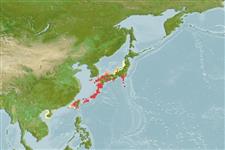>
Acropomatiformes (Oceanic basses) >
Creediidae (Sandburrowers)
Etymology: Creedia: Greek, kreesi, kreas = somebody that receives or keeps flesh (Ref. 45335); bilineata: Named in reference to the two stripes on the body.
Eponymy: John Mildred Creed (1842–1930), a friend of Ogilby’s, was an English-born Australian physician and politician. [...] (Ref. 128868), visit book page.
Environment: milieu / climate zone / depth range / distribution range
Ecologie
marien demersaal; diepte 3 - 5 m (Ref. 12706). Subtropical
Northwest Pacific: Japan.
Grootte / Gewicht / Leeftijd
Maturity: Lm ? range ? - ? cm
Max length : 3.2 cm SL mannelijk / geslacht onbekend; (Ref. 12706)
Korte beschrijving
Determinatiesleutels | Morfologie | Morfometrie
Dorsale zachte stralen (totaal) : 15 - 16; Anale zachte stralen: 17 - 18; Wervels: 42. Epurals 2; body with two yellowish brown stripes in life (Ref. 12706).
Found on shallow sandy bottom (Ref. 12706). Observed to abruptly rush out of the sand and immediately dive into nearby when disturbed (Ref. 12706).
Levenscyclus en paargedrag
Maturiteit | Voortplanting | Paaien | Eieren | Fecunditeit | Larven
Shimada, K. and T. Yoshino, 1987. A new creediid fish Creedia bilineatus from the Yaeyama Islands, Japan. Jap. J. Ichthyol. 34(2):123-127. (Ref. 12706)
Status op de Rode Lijst van het IUCN (Ref. 130435: Version 2024-2)
Gevaar voor de mens
Harmless
Gebruik door de mens
Tools
Speciale rapporten
Download XML
Internetbronnen
Estimates based on models
Preferred temperature (Ref.
123201): 20.5 - 26.3, mean 23.5 °C (based on 109 cells).
Fylogenetische diversiteitsindex (Ref.
82804): PD
50 = 0.5625 [Uniqueness, from 0.5 = low to 2.0 = high].
Bayesian length-weight: a=0.00102 (0.00046 - 0.00225), b=3.06 (2.88 - 3.24), in cm total length, based on all LWR estimates for this body shape (Ref.
93245).
Trofisch niveau (Ref.
69278): 3.1 ±0.4 se; based on size and trophs of closest relatives
Fishing Vulnerability (Ref.
59153): Low vulnerability (10 of 100).
